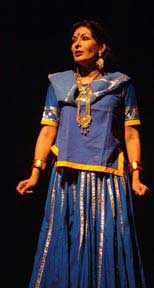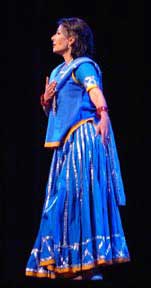Arts
An Idea Named Mallika

Mallika Sarabhai is turning into the feminist rabble rouser she often portrays
|
When Mallika Sarabhai strides onto the stage as Meera, the first thing you might notice is her short hair. “A Meera with a bob-cut” might seem almost iconoclastic. But artist, activist, dancer Mallika Sarabhai has never been one to conform to expectations. And her Meera is as she describes it “a feminist rabble rouser of the most wonderful kind.”
The definition might not be a bad one for Sarabhai herself who recently toured the United States with her latest production An Idea Named Meera. She has faced down the Supreme Court, the Narendra Modi government in Gujarat, taken on Public Interest Litigation on behalf of tribals and earthquake victims. And somehow found time in all of that to dance. Twenty years ago when she stuck out her neck for all kinds of social and political causes, other artistes cautioned her that she shouldn’t mix classical dance and activism. “They said all the invitations to perform would dry up,” says Sarabhai. “But that didn’t happen.” On the contrary she says dryly, “People who have become second wives completely against the law of the land are dancing to feminist themes thinking perhaps that’s where the bucks are.” In Sarabhai’s hands Meera does get a feminist re-incarnation. But Sarabhai insists she doesn’t really have to re-interpret Meera at all. She notes that Meera followed her own star 500 years ago in a Rajput royal family that even till a few years ago didn’t allow its daughters to show their knees in public. “In an age of expected responses, where even rebelling is co-opted, Meera is a clarion call for following your own belief,” says Sarabhai. She says most Indians only get a rather saccharine view of Meera, because the only things that are translated are Meera’s songs. But working with researcher Komal Kothari, Sarabhai found a treasure trove of unpublished documents. Some of that came to light at a 2003 conference in Los Angeles entitled – Meerabai – Saint for the 21st Century.
Meerabai of course is not the first legendary Indian figure to get the Mallika Sarabhai treatment. She shot to fame by being the only Indian in Peter Brook’s magnum opus Mahabharata in the 1980’s. She remembers how she was a “yellow ghost down with hepatitis” when Brooks offered her the role of Draupadi. A two-year contract became a five-year project as Sarabhai juggled her newborn son and a broken leg. She remembers that even there she had to fight Draupadi’s cause with Peter Brook. “Draupadi was not just a strong woman – she was Shakti,” stresses Sarabhai. She recalls how women would come up and tell her that they had never thought it was possible to be a feminist without negating womanhood till they saw Draupadi who could both love as a wife and as the same time pull Yudhishtira over the coals for his hypocrisy. She credits that experience as proving to her that she couldn’t be “an activist who also performs, or a performer who is also an activist. It has to be together.” Now that activist spirit breathes life into Meerabai too. Sarabhai’s Meera’s relationship with the Rana is very different from the one most Indians know. Here the Rana is jealous but also teases Meera about competition from Radha. He is baffled by her steadfast devotion to her Krishna but is also her protector. “Meera is made out to be holier-than-thou. She couldn’t have been,” says Sarabhai confidently. “For Meera, her Krishna-ness becomes her truth. It’s irrelevant that Krishna is her God.” Of course, that is bound to raise some hackles. Sarabhai got a taste of that controversy when she performed a piece called Search for the Goddess for the Smithsonian Museum as part of their show on the them of Devi. There she took on another icon of Indian womanhood – Savitri. “Nowhere does Savitri say, ‘I hrefuse to live if my husband dies,'” says Sarabhai taking on one of Hinduism’s best-loved archetypes. “Instead she says, ‘I hrefuse to let my husband die,'” asserts Sarabhai claiming that that is the reason Savitri should really be remembered. “She has to be eulogized not for patriarchal reasons, but because she was intelligent enough to defeat Yama, the god of death, in argument.” That might garner brickbats from some Hindus but she has also gotten her kudos from what she calls “serious students of Sanatan Hinduism.” Sarabhai says she is not insecure about her Hinduism and she is “proud to belong to the Upanishadic philosophy of Hinduism rather than the ‘No, it has to be so’ school of Hindutva.” After all she points out that “village women scold their Gods all the time.” Attitudes like that have brought her into headlong confrontation with the Narendra Modi government in her own home state of Gujarat. An police complaint was lodged against her in October 2003 accusing her of cheating and conspiracy. Sarabhai points out that the plaintiff, a dancer at her school, was really accusing Sarabhai of stopping her from “illegally immigrating to the US.”
When Sarabhai initially went into hiding after the complaint was issued, she says, she was overwhelmed by the support she received from human rights activists and artists, especially from abroad. “In Gujarat people are so frightened that the silence was deafening,” says Sarabhai. “People now come up, pat me on the back and say, ‘Didn’t you get our phone message?’ Of course there was no phone message.” But it hasn’t stopped her from speaking out. She got that trait from the family. While the rest of India knew Vikram Sarabhai as a scientist and Mrinalini Sarabhai as a danseuse, for Mallika they were just “incredibly open parents who demanded that their children have an opinion, that their children make value judgements.” In some ways, Sarabhai’s association with Meera stems from her parents as well. When she first started dancing professionally in 1977-78, the first piece her mother choreographed for both of them was about Meera. Mallika played the outside face of Meera who loves to play Holi and sing and dance while her mother played the spirit of Meera who unites with Krishna. But what was most special for Sarabhai was that it rekindled the spirit to dance in her mother who though running the Darpana dance Academy, had lost her motivation in the shock of Vikram Sarabhai’s death. “The first time I danced with her it was like a second birth for me,” says Sarabhai. Recently Sarabhai appeared on stage with both her mother and her daughter Anahita in a performance spanning three generations. For Mallika Sarabhai this Idea Named Meera is a return to those human roots of Meera. In fact, this performance also showcases two Meeras (the other played by dancer Daksha Sheth) and the two switch back and forth between each other. At the end of An Idea Named Meera, Sarabhai strips down to an all-black outfit. That to her symbolizes the end of Meera’s journey when after the death of her husband, the new Rana blames her for a plague in the city. “She says “Okay, I will go. I will leave on a cart, dressed in black, but I will take spirituality with me’,” says Sarabhai. What draws Sarabhai to figures like Meera and Draupadi are not the myths around them but that they are women “who dig deep into themselves to find one’s personal truth -there is a kind of personal plumbing you don’t see much of anymore.” Sarabhai sees that as a journey that never really ends. There is always another issue to speak out on. There are always more depths to explore. Not just in activism, but even in dance. Though she might be touring all over the world, Sarabhai remembers that her mother didn’t let her start Kuchipudi till she had about 15 years of Bharatanatyam under her pallu. At the end of a performance for Indians for Collective Action in Californian where she received the 2004 award, Sarabhai is surrounded by fans. An adoring father pushes his young daughter in front of her for an autograph. “She’s a Bharatanatyam dancer,” he says proudly. Sarabhai smiles and gently corrects him, “No, she is a Bharatanatyam student.” Then with unfailing grace she bends down, her eyes still lined with the kaajal from the evening’s performance and says, “Where do you want me to sign, sweetheart?” |



